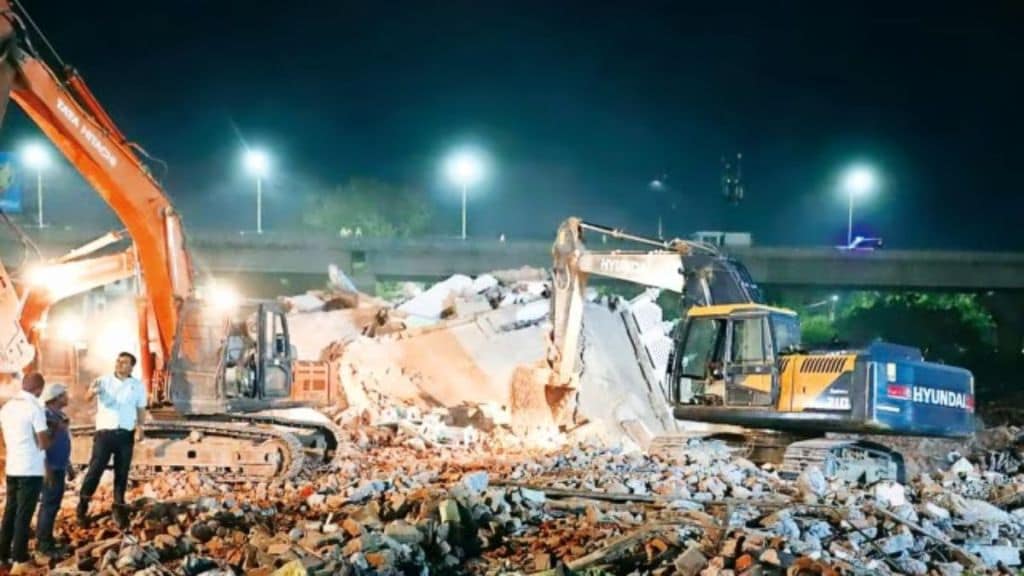The demolition of the remaining structures in Lucknow’s Akbarnagar area, which once accommodated 1,800 illegal constructions, earlier this week resulted in the complete evacuation of nearly 25 acres of land as per government orders. This marked the culmination of Lucknow’s largest anti-encroachment drive, clearing constructions spanning from the barrage on Faizabad Road to the Kukrail River in the city.
What was the aim of demolition drive?
The initiative was undertaken to reclaim the riverbanks of the Kukrail River and rejuvenate the ailing water body. Originating from Asti village in Bakshi Ka Talab, Lucknow, the 28-kilometer-long river eventually merges into the Gomti River. The project’s objective is to restore the river’s natural flow and ecosystem, which have suffered from human-induced degradation, while also developing its surroundings into an eco-tourism destination, in line with directives from Chief Minister Yogi Adityanath.
In an effort to enhance greenery and safeguarding water resources, Adityanath initiated a survey of the area, uncovering significant “illegal and extensive construction” on river land. Backed by a Supreme Court mandate, state authorities noted that encroachments by land mafias had transformed the river into little more than a drain.
Issue of unauthorised expansions and disputes
Residents pointed out that previous administrations had provided essential amenities such as electricity, roads, and water to those settling in Akbarnagar years ago. However, the area has long been plagued by unauthorised expansions and disputes.
Government sources revealed that these expansions violated environmental regulations, involving the construction of multi-storey residential and commercial buildings using fraudulent documentation. Consequently, under Adityanath’s administration, a demolition drive was launched, commencing in December 2023.
From legal battles to community resistance
The majority of Muslim residents of Akbarnagar approached the Allahabad High Court, which granted a stay until March 4, 2024. Subsequently, on March 6, the High Court permitted the demolition to proceed but directed the Lucknow Development Authority (LDA) to provide displaced residents with easy installment options. Dissatisfied with this decision, the residents then appealed to the Supreme Court, which affirmed the High Court’s ruling in May.
Throughout the process, the state navigated numerous challenges including land disputes, political controversies, legal battles, rumors, and protests. The administration pursued all legal avenues from the High Court to the Supreme Court to ensure adherence to the judicial process.
The demolition initiative began with Phase-2 of Akbarnagar, progressed to Phase-1, and finally concluded with the recovery of all encroached riverbanks on June 19.
Akbarnagar’s growth over past three decades
Initially sparsely developed, Akbarnagar experienced rapid expansion into a settlement as the capital city grew during the 1990s. Over the past three decades, more than 2,000 families have settled in the locality. The community primarily consists of a working-class population, with illegal establishments including homes, shops, factories, and places of worship springing up.
The area’s houses and workshops, notably those involved in furniture making and fabrication, have contributed to environmental degradation by disposing of their waste into nearby water bodies.
“The mafia, which had protection during the Samajwadi Party regime, built buildings and showrooms between the Kukrail river and a dam from 2012 to 2017. Also, illegal colonies were built with the help of forged documents even as residential and commercial construction is not possible in the area,” the government statement read.
Settlements and rehabilitation
While demolitions raise ethical concerns due to disruption of thriving commerce in the area, the government is ensuring proper rehabilitation for affected residents. Those impacted have been resettled in nearly 1,800 Pradhan Mantri Awas Yojana (PMAY) homes located approximately 10 km away in Vasant Kunj.
The clearance of over 10 lakh square feet of land aims to restore the natural flow of the river. Environmentalists in the city highlight that the water body, capable of sustaining aquatic life, has long suffered from contamination due to waste entering through 50 drains along its course. Uttar Pradesh Jal Nigam is actively identifying these drains and sewer lines responsible for polluting the stream.
With a focus on comprehensive area development, a budget of Rs 68 crore has been allocated for riverfront improvements. This initiative underlines the Yogi Adityanath government’s broader proposal to replicate similar actions across Uttar Pradesh, aiming to reclaim river basins and water bodies from encroachment.

